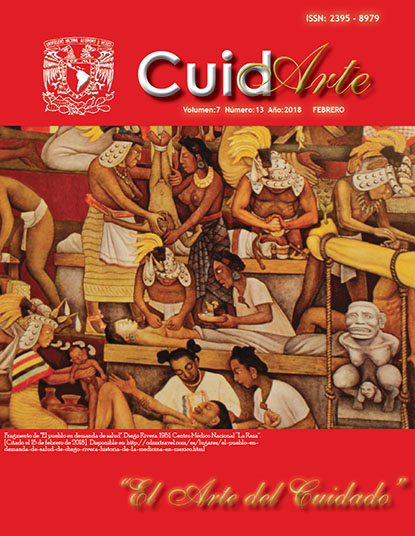Evaluating the effect of electrical stimulation for loss of body fat in women
Main Article Content
Abstract
Downloads
Article Details
Citas en Dimensions Service
References
(1) Instituto Nacional de Salud Pública. Encuesta Nacional de Salud y Nutrición. [Internet] México. 2012. [Fecha de consulta 3 Junio 2017]. Disponible en: http://ensanut.insp.mx/informes/ENSANUT2012ResultadosNacionales.pdf
(2) Adult Treatment Panel III. Third Report of the National Cholesterol Education. Program (NCEP) Expert Panel on Detection, Evaluaction and Treatment of High Blood Cholesterol in Adults. Executive Summary, NIH Publication 2011.
(3) Bancalari R, Díaz C, Martínez-Aguayo A, Aglony M, Zamorano J, Cerda V, y García H. Prevalencia de hipertensión arterial y su asociación con la obesidad en edad pediátrica. Revista médica de Chile,2011; 139(7): 872-879.
(4) Cordero CS, Alonso TJ. Prevalencia de Síndrome Metabólico y sus factores de riesgo en adolescentes. Desarrollo Científico Enfermería. 2011; 19 (9): 296, 300.
(5) Organización de las Naciones Unidas para la Alimentación y la Agricultura. El estado mundial de la agricultura y la alimentación. [Internet] Roma. 2013. [Fecha de consulta 16 Junio 2017] . Disponible en: http://www.fao.org/publications/sofa/2013/es/
(6) Guerrero J, Sánchez J. Factores protectores, estilos de vida saludable y riesgocardiovascular. Psicología y Salud ;2015; 25 (1): 57-71.
(7) Núñez-García MV, Ferrer-Arrocha M, Meneau-Peña TX, Cabalé-Vilariño B, Gómez-Nario O, Miguelez-Nodarse R. Factores de riesgo aterogénico en la población de 19 a 39 años de 2 consultorios del médicode familia. Rev Cubana Invest Bioméd [Internet] Jun 2007 ;26(2). Disponible en: http://scielo.sld.cu/scielo.php?script=sci_ arttext&pid =S0864 03002007000200006&lng=es.
(8) Ramírez-Cortés A. Programa de salud para revertir el síndrome metabólico (Tesis de Licenciatura). UNAM, México. 2015.
(9) Alonso J, Bautista R, Calzada D, Gutiérrez M, Mendoza R. Efecto del licuado de avena con manzana sobre dislipidemias y sobrepeso-obesidad. Revista CuidArte; 2012; 1 (2): 22-33.
(10) Ballesteros M, Guirado O. Los estrógenos como protectores cardiovasculares. Medicentro Electrón. 2012; 16(3): 148–153.
(11) Bertomeo A, Zambón D. La placa aterogénica: Fisiopatología y consecuencias clínicas. Medicina integral.2002; 40 (9): 394-405.
(12) Zárate A, Saucedo R, Basurto L, Martínez C. La enfermedad cardiovascular como amenaza actual para la mujer adulta mayor. La relación con los estrógenos. Ginecol Obstet Mex, 2007; 75(5): 286-291.
(13) Pérez M. El adipocito como órgano endocrino: Implicaciones fisiopatológicas y terapéuticas. Revista Med, 2007; 15(2): 225-242.
(14) Ortiz-Hernández L, Ramos-Ibáñez N. Sociodemographic factors associated with physical activity in Mexican adults. Public health nutrition, 2010; 13(07): 1131-1138.
(15) Supo J. Seminario de investigación científica. Arequipa, Perú.: Bioestadistico.com. 2014.Disponible en: http://seminariosdeinvestigacion.com/sinopsis
(16) Chaves C, Garganta R, Pinsach P. Comparação dos efeitos do treino cárdio-vascular com e sem electroestimulação na deplecção de gordura abdominal. Pre Cie. [Internet]. 2005 [Fecha de consulta 18 Junio 2017]. Disponible en: http://www.bemequer.com/estudios-electroestimulacion/electroestimulacion%20sobre%20la%20quema%20de%20grasa%20abdominal.pdf
(17) Eckert R, Randall D, Augustine G. Fisiología animal: mecanismo y adaptaciones. 3ra edición. Madrid: McGraw-Hill; 1990.
(18) Zarate A, Basurto AL, Saucedo GP. La obesidad: conceptos actuales sobre fisiopatogenia y tratamiento. Rev Fac Med UNAM. [Internet]. 2001; 44(2). México. Disponible en: http://revistas.unam.mx/index.php/rfm/article/viewFile/12588/ 11909.
(19) Martín DA, Ross DW, Drinkwater DT, Clarys JP. Predicción sobre tejido adiposo corporal, mediante la técnica de calibre para pliegues cutáneos: suposiciones y evidencia cadavérica. J Pub Stan. [internet] 1992; 1 (4). [Fecha de consulta 23 Junio 2017]; Disponible en: http://g-se.com/es/antropometria/articulos/prediccion-sobre-tejido-adiposo-corporal-mediante-tecnica-de-calibre-para-pliegues-cutaneos-suposiciones-y-evidencia-cadaverica-221.

